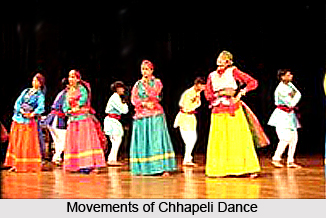 Chhapeli dance is performed by a male and female accompanied with dance and song. It involves a lot of instruments as well. In societies all over the world, sophisticated or otherwise, the concept of courtship dance is very much prevalent. It portrays the tradition and customs of the people of the region. It is not mandatory that the couples who participate in the dance forms are actually lovers, though the concept of the couple taking the dance floor was started to enhance the bonding between two people.
Chhapeli dance is performed by a male and female accompanied with dance and song. It involves a lot of instruments as well. In societies all over the world, sophisticated or otherwise, the concept of courtship dance is very much prevalent. It portrays the tradition and customs of the people of the region. It is not mandatory that the couples who participate in the dance forms are actually lovers, though the concept of the couple taking the dance floor was started to enhance the bonding between two people.
Style of Chhapeli Dance
Chhapeli dance is not as complex as the classical dance forms but is something which is delightful to witness. In this dance form, the male plays the role of a lover and the female essays the role of his beloved. In the dance, the female dancer holds a colourful handkerchief in the right hand and a mirror in her left hand. The male has slung on his left shoulder a Hudukka, and playing on it, provides the rhythmic pattern for the drum. The mirror, which is the most interesting part, symbolises something mysterious or vague. The dance is performed to win over the listeners and it can sometimes be quite mesmerizing. The tone of the music is often bright, gay and brisk accompanied with instruments like hurka, manzira and flute.
The couple dancing on the floor actually symbolizes the joys of love, beauty and romance. The female partner dances with a charming smile on her face and exhibits various elegant waist movements. The dancer dances to the lines of the song, mostly in praise of her beauty, sometimes even mocking her ways of making love. The song consists of solo chores and is sung by the Hurka players and their associates standing in a semi-circle behind the dancers.
Costumes of Chhapeli Dance
Chhapeli dance means various colourful costumes and decorative jewelleries. The female dancer decorates herself with heavy ornaments such as a garland of wooden beads, big ear-tops, rings and thick heavy bangles. She also adorns herself with a tiara on the head. The female costume consists of a long flowing skirt and a green or blue coloured full-sleeve jacket. Along with these, she also wears a `Kardhani` which is an ornament worn on the waist.
The male dancer usually wears a `churidar pyjama`, and either a single coloured or multicoloured shirt with a cap. He also ties a handkerchief around his neck.



















